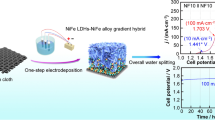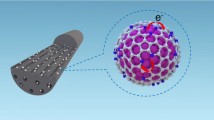Abstract
A three-dimensional reduced graphene oxide aerogel modified by sulfamic acid and ethylenediamine was prepared via one-step reduction self-assembly under atmospheric pressure within 90 °C heating constantly. The adsorption efficiency of palladium (II) was ~ 97.0% at pH 11 within 50 min by the prepared composite. While the composite exhibited adsorption for platinum (IV) at acid condition, giving a rising to an adsorption efficiency was 61.7% at pH 5. Only 25.8% adsorption efficiency of platinum (IV) was found at pH 11, and 17.0% adsorption efficiency of palladium (II) was obtained at pH 5. The adsorption capacity of the composite for palladium (II) was 80 μg mg−1 above, and the adsorption capacity of the composite for platinum (IV) was ~ 160 μg mg−1. The obtained palladium (II) and platinum (IV) can be eluted by urea and surfactant from the surface of the composite, respectively. Understanding the mechanism of the adsorption/desorption between palladium (II)/platinum (IV) and the composite, explored a promising way for recycling and enrichment of noble metal at a low concentration.









Similar content being viewed by others
Data Availability
The datasets used and/or analyzed during the current study are available from the corresponding author on reasonable request.
Abbreviations
- GO:
-
Graphene oxide
- Pd:
-
Palladium
- EDA:
-
Ethylenediamine
- CTAB:
-
Hexadecyl trimethyl ammonium bromide
- 3D:
-
Three-dimensional
- Pt:
-
Platinum
- rGO:
-
Reduced graphene oxide
- AAS:
-
Atomic absorption spectrometer
- B–R:
-
Britton–Robinson
- SEM:
-
Scanning electron microscope
- XPS:
-
X-ray photoelectron spectroscopy
- FT-IR:
-
Fourier transform infrared
References
J. Wang, W. Xu, H. Liu, F. Yu, H. Wang, Extractant structures and their performance for palladium extraction and separation from chloride media: a review. Miner. Eng. 163, 106798–106812 (2021)
S. Feng, K. Huang, Z. Huang, G. Liu, G. Zhang, G. Gou, Highly selective extraction of Pd (II) using functionalized molecule of 2-[(2-ethylhexyl) thio] benzoxazole and its Pd (II) extraction mechanism. J. Mol. Struct. 1230, 129639–129652 (2021)
M. Shao, S. Li, C. Jin, M. Chen, Z. Huang, Recovery of Pd (II) from hydrochloric acid medium by solvent extraction–direct electrodeposition using hydrophilic/hydrophobic ILs. ACS Omega 5(42), 27188–27196 (2020). https://doi.org/10.1021/acsomega.0c03255
G. Zhang, L. Zhang, Q. Wang, J. Guo, H. Wei, Y. Yang, Extraction and separation of Pd (II)/Pt (IV) by neutral sulfur-containing extractant from hydrochloric acid medium. New J. Chem. 45, 19467–19475 (2021)
H.T. Truong, M.S. Lee, Separation of Pd (II) and Pt (IV) from hydrochloric acid solutions by solvent extraction with Cyanex 301 and LIX 63. Miner. Eng. 115, 13–20 (2018)
L. Chen, Z. Huang, J. Chen, Solvent extraction and stripping of Pd (II) cyanide in cetyltrimethylammonium bromide system. Asian J. Chem. 25(18), 10169–10171 (2013). https://doi.org/10.14233/ajchem.2013.15213
S.P. Feng, K. Huang, Enhanced separation of Pd (II) and Pt (IV) from hydrochloric acid aqueous solution using 2-((2-methoxyethyl) thio)-1H-benzimidazole. Rare Met. 39, 1473–1482 (2020). https://doi.org/10.1007/s12598-020-01545-8
M. Chen, S. Wang, Z. Huang, J. Chen, M.J. Chen, Separation and recovery of Pd (II) and Pt (II) from cyanide liquors of Pd–Pt flotation concentrate via solvent extraction. Chem. Technol. Biotechnol. 92(7), 1699–1709 (2017). https://doi.org/10.1002/jctb.5168
K.S. Novoselov, A.K. Geim, S.V. Morozov, D. Jiang, Y. Zhang, S.V. Dubonos, I.V. Grigorieva, A.A. Firsov, Electric field effect in atomically thin carbon films. Science 306, 666–669 (2004). https://doi.org/10.1126/science.1102896
H. Zhang, D. Yang, A. Lau, T. Ma, H. Lin, B. Jia, Hybridized graphene for supercapacitors: beyond the limitation of pure graphene. Small 17(12), 2007311–2007322 (2021). https://doi.org/10.1002/smll.202007311
B.T. Ho, T. Lim, M.H. Jeong, J.W. Suk, Graphene fibers containing activated graphene for high-performance solid-state flexible supercapacitors. ACS Appl. Energy Mater. 4(9), 8883–8890 (2021). https://doi.org/10.1021/acsaem.1c01095
M. Ali, R. Riaz, A.S. Anjum, K.C. Sun, H. Li, S.H. Jeong, M.J. Ko, Graphene quantum dots induced porous orientation of holey graphene nanosheets for improved electrocatalytic activity. Carbon 171, 493–506 (2021)
O. Braun, J. Overbeck, M.E. Abbassi, S. Käser, R. Furrer, A. Olziersky, A. Flasby, G.B. Barin, Q. Sun, R. Darawish, K. Müllen, P. Ruffieux, R. Fasel, I. Shorubalko, M.L. Perrin, M. Calame, Optimized graphene electrodes for contacting graphene nanoribbons. Carbon 184, 331–339 (2021)
N. Liu, A. Chortos, T. Lei, L. Jin, T.R. Kim, W. Bae, C. Zhu, S. Wang, R. Pfattner, X. Chen, R. Sinclair, Z. Bao, Ultratransparent and stretchable graphene electrodes. Sci. Adv. 3(9), 1–10 (2017). https://doi.org/10.1126/sciadv.1700159
D. Ji, S. Low, S. Zhang, L. Liu, Y. Lu, Q. Liu, Smartphone-based electrochemical system for biosensors and biodetection. Methods Mol. Biol. 2393, 493–514 (2021). https://doi.org/10.1007/978-1-0716-1803-5_26
G. Yildiz, M. Bolton-Warberg, F. Awaja, Graphene and graphene oxide for bio-sensing: general properties and the effects of graphene ripples. Acta Biomater. 131, 62–79 (2021)
J. Li, H. Zhang, L. Liu, F. Meng, Y. Cui, F. Wang, Modification of graphene and graphene oxide and their applications in anticorrosive coatings. Coat. Technol. Res. 18, 311–331 (2021)
S.S.A. Kumar, S. Bashir, K. Ramesh, S. Ramesh, New perspectives on graphene/graphene oxide-based polymer nanocomposites for corrosion applications: the relevance of the graphene/polymer barrier coatings. Prog. Org. Coat. 154, 106215–106302 (2021)
R. Ishikawa, S. Yamazaki, S. Watanabe, N. Tsuboi, Layer dependency of graphene layers in perovskite/graphene solar cells. Carbon 172, 597–601 (2021)
K.P. Loh, S.W. Tong, J. Wu, Graphene and graphene-like molecules: prospects in solar cells. J. Am. Chem. Soc. 138(4), 1095–1102 (2016). https://doi.org/10.1021/jacs.5b10917
T. Mahmoudi, Y. Wang, Y. Hahn, Graphene and its derivatives for solar cells application. Nano Energy 47, 51–65 (2018)
Y. Sun, Y. Zheng, H. Pan, J. Chen, W. Zhang, L. Fu, K. Zhang, N. Tang, Y. Du, Magnetism of graphene quantum dots. NPJ Quant. Mater. 2, 5 (2017)
S. Ahirwar, S. Mallick, D. Bahadur, Electrochemical method to prepare graphene quantum dots and graphene oxide quantum dots. ACS Omega 2(11), 8343–8353 (2017). https://doi.org/10.1021/acsomega.7b01539
X. Chen, X. Hai, J. Wang, Graphene/graphene oxide and their derivatives in the separation/isolation and preconcentration of protein species: a review. Anal. Chim. Acta 922, 1–10 (2016)
L. Chen, Z.R. Xu, A three-dimensional nickel-doped reduced graphene oxide composite for selective separation of hemoglobin with a high adsorption capacity. RSC Adv. 6(61), 56278–56286 (2016)
Y. Zhang, J.W. Liu, X.W. Chen, J.H. Wang, A three-dimensional amylopectin-reduced graphene oxide framework for efficient adsorption and removal of hemoglobin. J. Mater. Chem. B 3(6), 983–989 (2015)
J.W. Liu, Y. Zhang, X.W. Chen, J.H. Wang, Graphene oxide-rare earth metal-organic framework composites for the selective isolation of hemoglobin. ACS Appl. Mater. Interfaces 6(13), 10196–10204 (2014). https://doi.org/10.1021/am503298v
L. Chen, D.H. Zheng, Y. Zhang, Y. Wang, Z.R. Xu, In situ self-assembled reduced graphene oxide aerogel embedded with nickel oxide nanoparticles for the high-efficiency separation of ovalbumin. J. Sep. Sci. 40, 1765–1772 (2017). https://doi.org/10.1002/jssc.201601322
L. Chen, L. Wang, D. Song, Z. Xu, Reduced graphene oxide aerogel with packaged TiO2 nanoparticles as a promising adsorbent for the separation of DNA from human whole blood. Sep. Sci. Plus 1(3), 217–224 (2018). https://doi.org/10.1002/sscp.201700044
B. Liu, P.J. Huang, E.Y. Kelly, J. Liu, Graphene oxide surface blocking agents can increase the DNA biosensor sensitivity. Biotechnol. J 11(6), 780–787 (2016). https://doi.org/10.1002/biot.201500540
C. Lu, Y. Liu, Y. Ying, J. Liu, Comparison of MoS2, WS2, and graphene oxide for DNA adsorption and sensing. Langmuir 33(2), 630–637 (2017). https://doi.org/10.1021/acs.langmuir.6b04502
M. Wu, R. Kempaiah, P.J. Huang, V. Maheshwari, J. Liu, Adsorption and desorption of DNA on graphene oxide studied by fluorescently labeled oligonucleotides. Langmuir 27(6), 2731–2738 (2011). https://doi.org/10.1021/la1037926
B. Liu, S. Salgado, V. Maheshwari, J. Liu, DNA adsorbed on graphene and graphene oxide: fundamental interactions, desorption and applications. Curr. Opin. Colloid Interface Sci. 26, 41–49 (2016)
G.X. Zhao, J.X. Li, X.M. Ren, C.L. Chen, X.K. Wang, Few-layered graphene oxide nanosheets as superior sorbents for heavy metal ion pollution management. Environ. Sci. Technol. 45(24), 10454–10462 (2011). https://doi.org/10.1021/es203439v
G.X. Zhao, X.M. Ren, X. Gao, X.L. Tan, J.X. Li, C.L. Chen, Y.Y. Huang, X.K. Wang, Removal of Pb (II) ions from aqueous solutions on few-layered graphene oxide nanosheets. Dalton Trans. 40(41), 10945–10952 (2011)
R. Sitko, E. Turek, B. Zawisza, E. Malicka, E. Talik, J. Heimann, A. Gagor, B. Feist, R. Wrzalik, Adsorption of divalent metal ions from aqueous solutions using graphene oxide. Dalton Trans. 42(16), 5682–5689 (2013)
W.S. Hummers, R.E. Offeman, Preparation of graphitic oxide. J. Am. Chem. Soc. 80(6), 1339–1339 (1958)
W. Chen, S. Li, C. Chen, L. Yan, Self-assembly and embedding of nanoparticles by in situ reduced graphene for preparation of a 3D graphene/nanoparticle aerogel. Adv. Mater. 23(47), 5679–5683 (2011)
H. Bai, C. Li, X. Wang, G. Shi, A pH-sensitive graphene oxide composite hydrogel. Chem. Commun. (Camb.) 46(14), 2376–2378 (2010)
G. Tang, Z.G. Jiang, X. Li, H.B. Zhang, A. Dasari, Z.Z. Yu, Three-dimensional graphene aerogels and their electrically conductive composites. Carbon 77, 592–599 (2014)
X. Jiang, Y. Ma, J. Li, Q. Fan, W. Huang, Self-assembly of reduced graphene oxide into three-dimensional architecture by divalent ion linkage. J. Phys. Chem. C 114(51), 22462–22465 (2010). https://doi.org/10.1021/jp108081g
L. Zhang, T. Wang, H. Wang, Y. Meng, W. Yu, L. Chai, Graphene@poly (m-phenylenediamine) hydrogel fabricated by a facile post-synthesis assembly strategy. Chem. Commun. (Camb.) 49(85), 9974–9976 (2013)
H. Hu, Z. Zhao, W. Wan, Ultralight and highly compressible graphene aerogels. Adv. Mater. 25(15), 2219–2223 (2013). https://doi.org/10.1002/adma.201204530
J. Li, J. Li, H. Meng, S. Xie, B. Zhang, L. Li, H. Ma, J. Zhang, M. Yu, Ultra-light, compressible and fire-resistant graphene aerogel as a highly efficient and recyclable absorbent for organic liquids. J. Mater. Chem. A 2(9), 2934 (2014)
J. Liang, Z. Cai, L. Li, L. Guo, J. Geng, Scalable and facile preparation of graphene aerogel for air purification. RSC Adv. 4(10), 4843–4847 (2014)
S. Stankovich, D.A. Dikin, R.D. Piner, K.A. Kohlhaas, A. Kleinhammes, Y. Jia, Y. Wu, S.T. Nguyen, R.S. Ruoff, Synthesis of graphene-based nanosheets via chemical reduction of exfoliated graphite oxide. Carbon 45(7), 1558–1565 (2007)
Y. Shao, J. Wang, M. Engelhard, C. Wang, Y. Lin, Facile and controllable electrochemical reduction of graphene oxide and its applications. J. Mater. Chem. 20(4), 743–748 (2010)
S.A. Zaidi, F. Shahzad, S. Batool, Progress in cancer biomarkers monitoring strategies using graphene modified support materials. Talanta 210, 120669 (2020)
N. Nekrasov, D. Kireev, A. Emelianov, I. Bobrinetskiy, Graphene-based sensing platform for on-chip ochratoxin a detection. Toxins (Basel) 11, 10 (2019)
P.J. Huang, J. Liu, Signaling kinetics of DNA and aptamer biosensors revealing graphene oxide surface heterogeneity. J. Anal. Test. 6, 20–27 (2022)
M. Zandieh, K. Patel, J. Liu, Adsorption of linear and spherical DNA oligonucleotides onto microplastics. Langmuir 38, 1915–1922 (2022). https://doi.org/10.1021/acs.langmuir.1c03190
Acknowledgments
The authors gratefully acknowledge the financial support provided by the Fundamental Research Funds of Yunnan Province for Youth (Nos. 202001AU070134 and 202001AU070112).
Funding
This work was financially supported by the Fundamental Research Funds of Yunnan Province for Youth (No. 202001AU070134 and No. 202001AU070112).
Author information
Authors and Affiliations
Contributions
LC contributed to design the experiment, writing—original draft, and writing—review and editing; TY and QS contributed to writing—review and editing; YL and RL contributed to experiment and data collection.
Corresponding authors
Ethics declarations
Conflict of interest
The authors declare no conflict of interest.
Rights and permissions
Springer Nature or its licensor (e.g. a society or other partner) holds exclusive rights to this article under a publishing agreement with the author(s) or other rightsholder(s); author self-archiving of the accepted manuscript version of this article is solely governed by the terms of such publishing agreement and applicable law.
About this article
Cite this article
Chen, L., Li, YL., Li, RX. et al. Three-dimensional self-assembled reduced graphene oxide composite as a promising adsorbent for the collection of palladium (II) and platinum (IV) in a low concentration. J IRAN CHEM SOC 20, 2861–2870 (2023). https://doi.org/10.1007/s13738-023-02882-y
Received:
Accepted:
Published:
Issue Date:
DOI: https://doi.org/10.1007/s13738-023-02882-y




